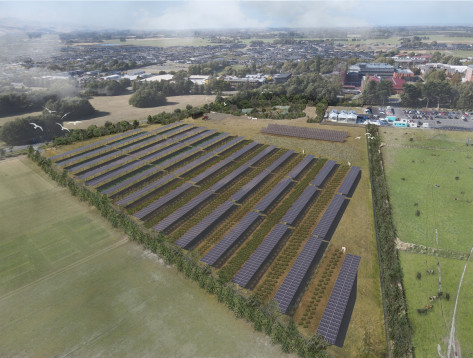New Zealand’s first ‘high-quality’ AgriPV solar farm unveiled

The rows of bifacial PV modules will be mounted on an east-west tracking system with two different height configurations. This will allow commercial crop cultivation alongside and beneath the module structures. The system will generate around 2.3 GWh of renewable energy annually.
In addition to the main array, a second, smaller array will be dedicated primarily to multipurpose research and will feature fully manual control, different height and panel configurations, and different panel technologies.
Subject to resource approval, the project will be built on a four-hectare site owned by the University adjacent to the campus at the corner of Springs and Ellesmere Junction Road.
Scheduled for completion in mid-2025, the energy park will increase the university’s total electricity generation capacity to approximately 3.56 GWh and, after upgrading the heating system to 100% electric energy, will meet 18% of the campus’s annual electricity needs.
Susie Roulston, Chief Operating Officer of Lincoln University, said the Lincoln University Energy Farm was critical to the university’s goal of becoming carbon neutral by 2030 and net zero carbon by 2050.
“Our multidisciplinary approach has enabled decarbonisation and a novel AgriPV system. The Lincoln University campus is both a model of sustainable practices and a showcase for transformative land use,” said Roulston.
The university said the project was the “first demonstration of high-quality agricultural photovoltaic systems in Aotearoa New Zealand.” It added: “Although livestock farming is common in solar installations locally and internationally, this approach is primarily to control grass growth and is of relatively low value.”
New Zealand’s AgriPV landscape
As the university mentions, while this is the first project to look at “high-quality” agri-PV, it is not the first solar park to incorporate agri-PV. Instead, several projects have incorporated it into their plans.
For example, New Zealand solar developer Lodestone Energy announced at the end of June 2024 that it would build a 220 MW agriPV project on the country’s South Island.
The project will cover 340 hectares, about 1.5% of Haldon Station’s total agricultural land, and Lodestone plans to start construction next year. While the company has not specified which modules will be used for the project, it will add to a growing portfolio of solar projects already in operation. Lodestone currently operates the 33MW Kaitaia project and the 32MW Rangitaiki project in the country’s North Island.



